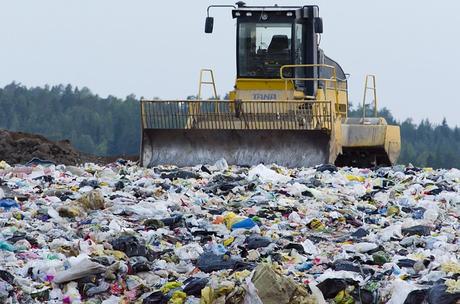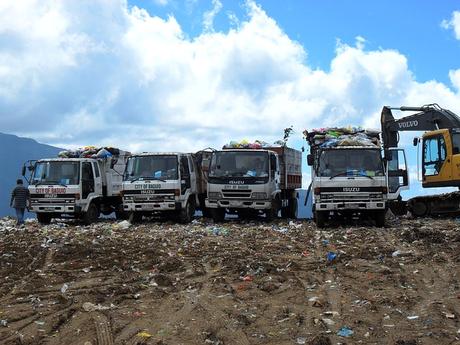What are Landfills?
Landfills are sites designated for dumping rubbish, garbage, or other sorts of solid wastes. Historically, they are the most common means of disposing solid waste which is either buried or left to pile in heaps. Landfill is a common phenomenon around the world, especially due to the increased number of wastes from our homes, schools, offices, hospitals, and markets. Some landfills are well managed and designed as part of integrated waste management.
However, most communities leave the landfills unattended to which cause land pollution and uncontrolled buildup of all sorts of solid waste materials. Here are the causes, effects, and solutions to landfills.
According to Wikipedia,
“A landfill site (also known as a tip, dump, rubbish dump, garbage dump or dumping ground and historically as a midden) is a site for the disposal of waste materials by burial and is the oldest form of waste treatment. Historically, landfills have been the most common method of organized waste disposal and remain so in many places around the world.”

Serious Causes of Landfills
-
Solid waste
Solid waste is the number one contributor of landfill waste disposal. Homes, schools, restaurants, public places, markets, offices and so on produce a great deal of rubbish, garbage and used materials. The bulk of these wastes eventually end up in the landfills. Examples of the solid waste materials include wood, paper, plastic, broken furniture, glass, grounded cars, obsolete electronic products, and hospital and market waste.
Because most of these waste materials are non-biodegradable, they heap in the landfills where they stay for years. The scenario is even worse for poorly managed waste disposal systems and normally results in damage to the land and the surrounding environment.
-
Agricultural waste
Agricultural wastes arise from waste materials generated from animal manure, crop, and farm remains. The solid wastes like the animal manure and other agricultural by products are collected and dumped in the landfills. These agricultural remnants are highly toxic and can contaminate the land and water resources. Once in the landfills, the wastes remain there for years impacting on soil quality and polluting the land.
-
Industry, manufacturing, and construction waste
Industrial processes, construction activities and power plants produce a wide range of solid byproducts and residues. The predominant waste products are generated from oil refineries, power plants, construction works, pharmaceuticals, and agricultural product producers. The solid wastes usually find way to the landfills.
As an example, oil refinery processes produce petroleum hydrocarbon byproducts while construction works generate wood, plastics, and metal wastes. Regardless of the fact that industrial manufacturing, power generation and construction works are regulated, their byproducts and residues from time to time find way to the landfills.
-
Urbanization and population growth
Increasing urbanization and population growth rate is considerably accountable for the increased number of landfills across the world. With the increase of population and urban growth, the demand for manufactured products and materials increases. As the demand increases, so does the increase of solid wastes.
In particular, plastic pollution has been on the rise in the first decade of this century due to rapid urbanization and population growth and most of the used plastic materials simply end up in the landfills. In most urban areas, plastics form the greater part of the landfills and constitute about 80% of all the municipal waste.
Drastic Effects of Landfills
-
Air pollution and atmospheric effects
There are more than ten toxic gases emitted from landfills, of which methane gas is the most serious. Methane gas is naturally produced during the process of organic matter decay. On this account, EPA records that the methane expelled during the decomposition of organic matter in unmanaged landfills has the potential of trapping solar radiation 20 times more effective than carbon dioxide.
The outcome is increased urban and global temperatures. Aside from the methane gas, other household and agricultural chemicals that find way to the landfills like bleach and ammonia can generate toxic gases that can greatly impact the air quality within the landfill vicinity. Dust, particulate matter and other non-chemical contaminates can also be expelled into the atmosphere, further contributing to air quality issues.
-
Ground water pollution
The primary environmental problem arising because of landfills is groundwater contamination from leaches. There are several hazardous wastes that find way into the landfills and once they are there, the inevitable is the natural deterioration of ground water.
The toxic products in the landfills range from industrial solvents to household cleaners. Besides the chemicals from household and industrial products, electronic wastes contain lead, mercury and cadmium.
A huge percentage of these landfill toxins infiltrate the soil to reach the fresh water waterways, which eventually end up in the domestic water and sadly enough, the foods that we consume. The pollution can also adversely harm animal and plant life. Research reveals that 82% of landfills have leaks.
-
Health effects
Increases in the risk of severe health implications such as birth defects, low birth weight, and particular cancers have been reported in individuals living next to landfill areas in numerous studies. For instance, TCE is a carcinogen element often originating from landfill leachate. Other discomfort and self-reported symptoms for people living next to the landfills include sleepiness, headaches and fatigue.
The effects are linked with the toxic actions of the chemicals present in the landfill wastes. From contamination of the air with harmful gases to water pollution, the outcome is adverse human health effects. Landfill toxic gas releases and water pollution are as well associated with lung and heart diseases respectively.
-
Soil and land pollution
Landfills directly render the soil and land where it is located unusable. It also destroys the adjacent soil and land area because the toxic chemicals spread over the surrounding soil with time. The upper layer of the soil is damaged, distorting soil fertility and activity and affecting plant life. Industrial and electronic wastes in the landfills destroy the quality of the soil and land thereby upsetting the land ecosystems.
-
Economic costs
The economic and social cost of landfill management is very high. From the management of the gases coming out of the landfills to groundwater contamination management, and ensuring compliance with environmental regulatory policies drains a lot of the municipality’s and tax payer’s money in terms of integrated waste management.
Because most of the materials disposed in the landfills take millions of years to decompose, designing effective strategies and facilities for managing landfills requires high capital investments with regards to management and recycling initiatives.
-
Landfill fires
Landfill gases together with a substantive amount of landfill waste, can easily start a fire. Once fires are ignited, it can be challenging to put it out and further cause air pollution. If not put out immediately, they can get out of control and destroy the neighboring habitats.
Methane is notably the most flammable and combustible gas in the landfill and as such, given its abundant supply it can create havoc. Combustion of the landfill even worsens the situation as the burning of the chemicals adds more chemical load to the area.

Impressive Solutions of Landfills
-
Design and implementation of integrated waste management
The construction of modern landfills with well-engineered and managed disposal facilities can significantly lessen the impacts of landfill on soil, air, and water. Landfills that are well-designed and operated ensure compliance with environmental preservation requirements and it ultimately ensures that the environment is free from contaminants.
The use of such designs also ensures the landfills are not located in environmentally-sensitive areas and are incorporated with on-site environmental monitoring systems. With on-site environmental monitoring systems, signs of land fill gas and groundwater contamination can be easily detected and controlled.
-
Recycle, Re-use, and reduce
Landfill management will always remain a major environmental if communities don’t embrace the need of recycling, reducing and reuse. The increased demand of manufactured products is what increases the final waste products that end up in the landfill. In this view, the use of recycling systems for electronic wastes, plastics, paper, metal, glass and other non-biodegradable materials can provide an effective means of reducing the landfill effects.
Reducing our demand for manufactured products and embracing re-use can equally favor reduction to both the toxicity and volume of waste that end up in the landfill as waste. People have no option but to embrace the art of using manufactured products to the end of their useful life. These can be split into the following simple steps:
- Respect the planet: A deep gratitude and recognition of how beautiful the planet is, including the interdependence of living and non-living things will help us exploit the planet positively while also giving it time to flourish and rejuvenate.
- Rethink our consumption needs: After huge purchases, we find out that most of the products don’t make us as happy as we thought they would. In going about our life experiences, we should reconsider our consumption habits and also buy what we think is necessary and useful for the betterment of both our well-being and nature.
- Reduce wastage: Spending our money on things we don’t need drains our wallets and destroys our environment because of waste accumulation. Only spending on what is needed saves out planet and keeps it environmentally friendly. Furthermore, it contributes to a cleaner and more efficient environment since it establishes the need for meaningful production and distribution of manufactured products.
- Reuse products: Reusing the products that we have already bought keeps them away from the landfill. We can buy used items from internet sites like E-bay, second-hand stores, garage sales, or otherwise donate the items that we don’t use.
- Recycle materials: Recycling is one of the best solutions for landfill management. Materials such as plastics, cans, paper and glass can be recycled.

